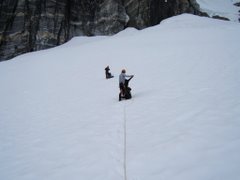Again, I am in the lab, sinking into the swivel chair in flourescent light optimism. My standards are all faring well today creating nice linear calibration curves---to accurately determine what is in my glacier samples... all is well so far (knock on plastic) in spite of the fact that the glass sample chamber was pink with other people's high concentration samples yesterday. Pink is the color of evil and iron oxidation. Anthony boiled the pink away in nitric acid, and my blanks are clean to the ppt. That's a few drops in the ocean. I'm also writing a paper. Its not taking long. Writing is the easy part... its the ICPMS that is the hard part. The instrument has so many special parts... the contamination of cones, the plugging of nebulizers, the settling of sediment...the paper is not taking long at all... I finished most of it last week...
To more adventures in science in the new year!
Thursday, December 28, 2006
Thursday, December 14, 2006
2000- Juneau Icefield Research Program
 It's the summer after I started my Master's program at OSU. Ben (who I later stumbled upon in Antarctica at 2 in the morning in the McMurdo cafeteria as his disrespectful roommate entertained too much company) and I led a few students down the Gilkey Trench to explore supraglacial melt ponds in the compression zone below the ice falls. We spent all day descending the nunatak adjacent to the ice falls. Exhausted... physically and mentally. We trudged to camp at the medial moraine a kilometer away, the pace quickens with dreams of dinner. I'm ready to be a hero, carrying with me some much sought after mac and cheese. By the time we reach camp, we are drooling... but prematurely. A grizzly bear looms a few kilometers away. And it's plodding our way. Four of us jump on a boulder to match the bear in size, hoping to divert its course. TO no avail!!! We are feeble compared to this trucklike animal. We are nervous.
It's the summer after I started my Master's program at OSU. Ben (who I later stumbled upon in Antarctica at 2 in the morning in the McMurdo cafeteria as his disrespectful roommate entertained too much company) and I led a few students down the Gilkey Trench to explore supraglacial melt ponds in the compression zone below the ice falls. We spent all day descending the nunatak adjacent to the ice falls. Exhausted... physically and mentally. We trudged to camp at the medial moraine a kilometer away, the pace quickens with dreams of dinner. I'm ready to be a hero, carrying with me some much sought after mac and cheese. By the time we reach camp, we are drooling... but prematurely. A grizzly bear looms a few kilometers away. And it's plodding our way. Four of us jump on a boulder to match the bear in size, hoping to divert its course. TO no avail!!! We are feeble compared to this trucklike animal. We are nervous.We radio our above glacier campmates, they advise us to leave fast. We grab some fuel to "light and throw "at the bear--- or if we escape, to use for dinner...
Suddenly the bear is within 100 meters of us. We don't cramponing until 1 a.m., carefully navigating over watery streams... insightful revelations from the undergraduate with us...fear lays it all out....
That night, we rest on the firm and spiky ground of the nunatek to our west. Precariously steep, we set rocks underneath---they'll be no plummeting in the middle of the night. I'm thanking my cheap immitation thermarest that can be blown up in 3 segments... to huge pillows. I sleep like cotton. Before my eyes sand, we witness a spectacular aurora, dining on the finest mac and cheese. Ben and I had a laugh imagining throwing a fire bomb at the grizzly. Its funny from our perch.
The picture is from the next morning.
Monday, December 11, 2006
in a white cave
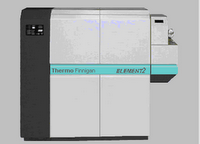
I'm in the windowless basement of Mendenhall Labratory. It is desolate,the hum of the ICPMS and the faint smell of acid... it feels like a cave, but warm, and I am here by choice. I'm lucky that it is warm, because the furnace is constantly failing, and we must look at our own breath. Similarly, the air-conditioning in the summer fails and we must suffer in our long sleeves(lest the acid drop on our bare skin).
As for now, my mind is sterilized by the hum and I'm having difficulty taking notes, let alone writing Christmas cards, or better yet, looking at data...
My mind drifts worse than the instrument, I'm thinking back fourth graders..... I lit a match and put it in a bottle (lowering the air pressure), then I stuck a hard boiled egg on top and WHOMP, The egg was suctioned in with a thud.
Saturday, December 09, 2006
1998
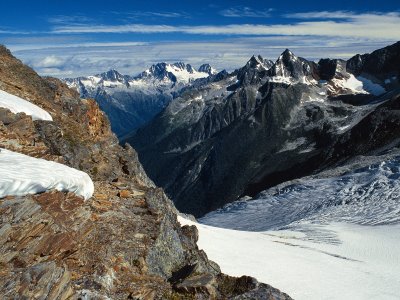
Its the summer of 1998.
Today it is hot and bright. It is 80 degrees going on Mojave the whole week I am alone, except for the final snowy morning my socks freeze like daggers to the laundry cord. My skin turns bright red and I carefully inspect by looking into the blurry lid of my cooking pot. I dutifully measure the lake level in this trapped lake of the Illicillawaet Glacier every morning, noon, and night. The only thru-hiker will be a fury grizzly man whose yellows teeth make me feel even younger. I smile and pretend to be a lumberjack. Puffing my arms out to defeat him should he gnash his stained fangs.
Soon my supplies dwindle and I am low on food and saline solution. That night a beautiful bird helicopter drops me my dreamed of supplies... sadly there is no saline, no food, only some hot chocolate and some rum. Did I miscommunicate??? I feel resigned, having a dinner of kidney beans, laughing more than crying because I am 19 and baffled. It's so beautiful I want to stay forever, journaling my surroundings, becoming one with this melting sad glacier.... and with only booze, one journal, and scratchy contacts I suspect my stay will have to end soon. It is in this sunset that I take a deep breathe, lasting well beyond my hike out.
Illicillawaet picture from: (this most resembles the glacier as I remember it in 1998) www.ljplus.ru/img2/pycaky/Illecillewaet-Glacier,-British-Columbia,-Canada.jpg
Thursday, November 30, 2006
1997

Its August 1997 and I'm in Iceland looking for my tent. Maybe it has blown into the future... a katabatic breath pushed it down valley while we were exploring. Returning to camp we found only Chris's tent survived unscathed. The ShopKo tent. Other tents scattered across the terminus of the Svinafellsjökull ..French tourists rescued our luggage saving our thermals (to wear well into the next few decades). And we stayed in a hostel with warm-faced blond people. Icelandic winds are hostile. While the land is forgivingly warm...soothing geothermal pools. (below- growling at the glacier that ate my tent...)
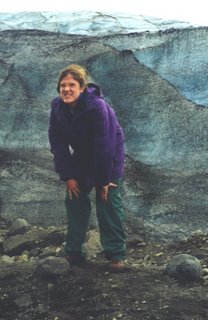
Friday, November 17, 2006
Slow Drip
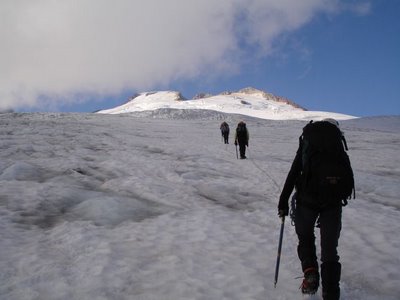
Andrew Revkin, NY Times Science Writer, spoke yesterday at the Ohio State University " The Daily Planet: A Journalists Search for Sustainability from the Amazon to the Arctic". Revkin, who has written climate change stories for decades, declared, "global warming is not new to the media". Climate skeptics and new climate studies receive much more media attention. Revkin acknowledged we've known for many years that fossil fuel burning elevates carbon dioxide and creates temperature rise. Revkin said this is a "slow drip story". Greenland's eventual melt within the next century is unstoppable if we continue business as usual. The damage will be painfully huge with 7 meters of sea level rise. Slow climate change is no news compared to wars, oil prices, the stock market, job security.
The real story is that although many of us understand the consequences of a warming earth, we are still doing very little to change our future. This morning, I got in my car and went though the coffee drive-thru. The educated may be driving hybrids now, but they're still driving like everybody else. Even those of us who are aware are not taking charge or our futures. At what point will we?
(photo from Erin Pettit GOI 2006)
Wednesday, November 08, 2006
Road Salt and Crayon Factories

Today, the kids made hills. They stuffed garbage bags briming with newspaper and stretched out their lovely landscapes...perfectly ready for imaginary settlement and eventual industrialization...
I gave them a list of ingredients--- asking them, what role, or job, each ingredient should represent in our town. The ingredients and responses are below.
Coffee- Starbucks! Landscaping! Farming! (A holler came "do you even know what landscaping is?")
Soap- Houses. Hotels. (They both wash lots of towels!!)
Oil- Oil Refineries!!! (yes, this was yelled--- I must talk about oil a bit much)
Salt- Food for animals in farms... Road Salt!! (I'm so proud of the kid who said road salt, my eyes get a little misty--- in most states people have completely altered stream chemistry with road salt.
Powerade- A crayon factory (I went with it...)
The kids put these ingredients spread out on their landscape... And then it rained... and all of the ingredients merged into one lake in the middle of the mountain range. A few well placed factories were spared... but, most of the kids were living in the runoff of a crayon factory?
We're all in one big lake together. Sometimes the blue gets mixed in with the red... All of us a little bit more colorful for the experience...
(photo: http://www.worldvillage.com/wv/school/html/reviews/crayonf.htm)
Thursday, November 02, 2006
Awake in the time of the bobbleheads
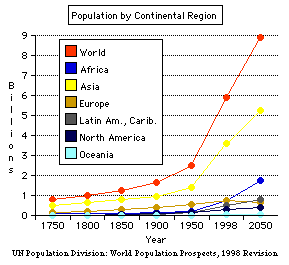
By 2050 the UN predicts global populations will reach 8.9 billion; a staggering increase of 2.1 billion people from today’s population. In the meantime, oil production in the Middle East is projected to more than half (Simmons & Company). Non OPEC supplies will not keep pace, our ability to discover new oil is outpaced by growing global demands. It is no wonder our President and Congress have called for energy “independence” by 2020. This will require more than a few new green communities and some work to develop hydrogen fuel cell. Our budgeted 2007 federal science and technology plus energy spending equal 26.1 billion or less than 1% of national spending. What do our political candidates propose to solve this? Or is the goal of energy independence as ambiguous as the advertisements?

Tuesday, October 24, 2006
Mentos in Lake Vostok


Ah Ha! Science thrills again! Today the fourth graders flung themselves at me with full-force for wowing them will Mentos and Diet Coke. After 2 spectacular eruptions- two kids erupted their own homemade volcanoes using standard volcano fare- vinegar and baking soda... I thought it would be a shame if they got sprayed with Diet Coke. Diet Coke carbonation is a great analogy for carbon dioxide release by real volcanoes...
All the Mentos and Coke got me thinking about my favorite lake... LAKE VOSTOK. A lake as large as Lake Michigan covered by two miles of ice!!!! What's in that pesky Lake--- much pressurized gas from dissolved rocks---That's a lot of carbon dioxide.... think about dropping many truckloads of Mentos into the lake.... and Wazammm!!! We won't have to resolve how to keep from contaminating the Lake anymore--- it will spray the entire continent...
Monday, October 16, 2006
Make your own glacier

When I first moved to Ohio my officemate, Jim, dubbed me "Ice". "Hey, Ice what are you up to later? "Ice, do you have lab today?" "Ice, are you going out this weekend?" After a few months, my name was officially Ice...at least to my officemates...
Today, although I have reclaimed my birthname, I feel a bit like "Ice". My nose dripping like summer melt... and more importantly, my freezer is growing a glacier. This is no broken defrost...this is an intentional glacier. Yesterday, I carefully scooped sand from our backyard (Trey is laying some pavers, so I had to be sneaky)... I was cautious not to scoop any worms, as this causes many young fourth and fifth graders to squirm. (Even if they would be tame and rigid). I spread sand in a cake pan, shallowly carpeting the entire bottom. Then, I poured in some water and carefully balance this concoction on the top rack of the freezer at a 30 degree angle--- propped strategically on an Eggo box. The water swooshed to the lowered end of the pan.... with any luck it will be well frozen today...Soon I will be tipping the pan in the opposite direction to see if the lovely beast will slide down the sand on its wet bed. Just in case, I'm bringing a hair blower to speed the process up...
However, this glacier is likely to be outtrumphed in the students eyes by the more gooey glacier idling in my refridgerator...(unless of course, I did miss a poor worm).... its amazing how glue, borax and water congeal into a wonderful example of glacier internal deformation....
This glacier was a pain to scrape from underneath my fingernails and out of my wedding ring... but it will impress the kids. And today, they will love science.
Sunday, October 08, 2006
Slime: My new day job

This week I'm living under the pulsing neon of the windowless analytical lab(finishing up the Antarctic samples from last winter). Meanwhile I am washing bottles in three acid baths... each soak 1 week, then triple bagging them in ziplocks for Becki and Joel to take with them to Antarctica...these are cleannnnn bottles.
Why no ice this winter? A new endeavour--- I am a National Science Foundation GK-12 fellow (the simple explanation- I make bacterial gardens (above) and bring in dirt for kids to learn science from) I've got two classes from two Columbus Public schools. The kids are amazing--- they largely design their own experiments to study everything from erosion to food webs...
For this weeks activities, my rock loving husband is digging in the basement through his crates of rocks--- searching for trilobites... I am dividing brownie and cake mix into batches for the kids to make their own desert soil and muddy lake bottoms.... found some swedish fish for them to make into little sugary fossils.... a few of them experienced predation at the stake of my mouth...
Its really rewarding to do this work, a nice follow-up to Girls on Ice... and the kids are fun, inquisitive and sweet.
And I love our noxious gardens!!!! It reminds me of the primative begginings of our own planet and the strange brew of microbes living in anoxic conditions....
A little lab work never hurt, just need some more sun--- heading out to get some!
Saturday, September 09, 2006
A goat in the mist


It’s cold, so cold the girl huddle close to the whisperlite stove, willing the water to boil. We are back at camp, after a long day in the field. It is Lucia’s turn to warm us up, the sixteen year-old has traveled to Mount Baker, Washington from Spain. We clap our hands together mimicking any movement that Lucia makes. As the laughing starts, the water boils, and we are ready to begin our evening discussion drinking tea and cocoa. I reflect on the long days hike over the Easton Glacier, our failed attempt to look at the Deming Glaicer, covered in thick clouds. The 9 high school girls kept their attitudes positive and we had a good time looking down crevasses and tracing Gatorade as it flowed around the ice crystal boundaries. There is so much to see that is immediately under our feet. The girls smile at each other and trade candy bars back and forth keeping warm in the near freezing mist.
We have been thinking about the connection between science, religion, and art, a discussion that started as we lunched and waited for clouds to lift at the Deming overlook. This is a staple question asked by Girls on Ice inventor Erin Pettit. For Erin, the world is an amazing place to explore, and unknown journey. It is nice for analytical me, to be reminded by Erin, CeCe, and the (brilliant) girls of how much we don’t know.
Lately, I have been strategizing ways to communicate science, especially global warming findings to the public. In doing this, I try not to deal too much with the unknown, and offer as many facts as I can to any ear that will listen. It is nice to shift focus for a while and think about how many things there really are left to understand, and how we are only just beginning to find out answers to some of the mysteries of the universe.
Over hot drinks, the girls share their insights on what defines a wilderness experience. The fog lifts slightly, and we are able to see the next moraine over. A mountain goat stands staring down at us. Quiet, and strong, and then back into the mist the goat disappears.
(the girls had to record their experiences for one day-so I thought I might too). The pictures don't match the day.
Monday, August 28, 2006
Getting Harder to Drive On Glaciers

EOS (a weekly science periodical produced for and by scientists) published an article with growing evidences that global warming has likely been underestimated.
The eight reasons-
1) There are two types of aerosols (molecules that reside in our atmosphere)
-those that cool the atmosphere
-those that warm the atmosphere
(whether an aerosol cools or warms largely depends on how much the aerosol absorbs or reflects solar radiation)
The article suggest that future global warming models underestimate warming because the aerosols that warm stay in the atmosphere longer than those that cool.
2)Permafrost is melting fast and furiously. When permafrost (frozen ground) melts the land surface becomes less reflective and more solar radiation is absorbed--- making more permafrost melt.
3)Plants are not breathing/removing as much carbon dioxide as we thought. Plants of many types and at many latitudes have now been monitored--- also our land use practices are favoring draining swamps and burning lands resulting in increased atmospheric carbon dioxide.
4)Arctic sea ice is melting and retreating rapidly--- less ice means less sun is reflected and more heat absorbed by the dark ocean surface... causing more melting (a good analogy is to compare standing on dark asphalt to standing on a light-colored concrete on a sunny day)
5)Atmospheric circulation is intensifying. This is thought to more effectively spread the heat...and create more dramatic weather changes around the world (from droughts to floods)
6)Rapid ice shelf break-up in the Antarctic Penninsula and the increased melt of the Greenland Ice Sheet and acceleration of its outlet glaciers. The melting now going on in Greenland is huge!!! Weather stations that have existed for decades on the snowy and icy edges of Greenland are now surrounded by huge lakes...or completely submerged once again the dark water is absorbing more heat and causing additional melt...
7) Record hurricanes--- high sea surface temperatures (especially in the shallower regions nearshore) promote more hurricanes--- we had the first recorded South Atlantic Hurricane
8) Ocean circulation is changing fast. The North Atlantic has slowed down much faster than originally predicted- this may be due to precipitation changes,and/or increased ice melt.
These eight evidences are well supported by highly recognized science journals... but not often talked about in the news (excepting maybe hurricanes...) Those of us studying these dramatic changes are talking, but are we talking loud enough and to the right people. What is the best way to do this? I think of this often, and try to keep my lights on a little dimmer and look for ways to conserve energy. There are those that think natural geologic forcings are stronger than anything people will do to alter this planet. Because volcanoes, rock weathering and plants naturally alter the carbon cycle and the amount of carbon dioxide in the atmosphere our little bit of carbon burning won't matter. This is much like saying that because most rain is naturally acidic so we might as well burn more coal because more acidic rain is not a big deal...(tell that to an angler in the NE US where fish kills grew rapidly before the clean air act).
Another thing--- that little bit of carbon dioxide people have added to the atmosphere by burning carbon that was once buried in the earth (fossil fuels) is enough to raise temperatures a few degrees above natural levels...Enough to completely melt Greenland possibly in my lifetime.
(Pictured is the Athabasca Glacier, a glacier I helped Dr. Melinda Brugman put a weather station on in Alberta Canada in 1997--- Trey and I went there for our honeymoon in 2003 and the tourist bus that rode onto the glacier only operated because people shoveled snow and ice into the increasingly larger crevasses that were melting out more aggressively each summer...it is likely the snow coach will have to become more creative as melt continues to accelerate)
Tuesday, August 22, 2006
Ice Axes of Evil

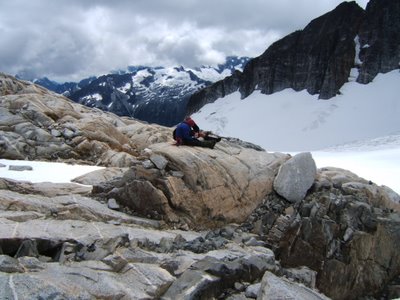
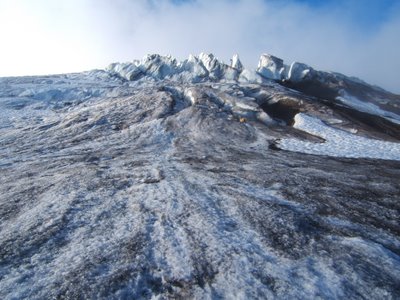
 I am seventeen and blowing up a glacier. I love glaciers so much that I destroy them. Now, rather than blow them up, I get into my car driving in circles to push as much carbon into the atmosphere as I physically can. A mathmetician said to me, variance. There is just too much variance to know whether humans are responsible for the warming we are witnessing in our present environment. How about another math word- correlation. Carbon dioxide versus temperature change, 650,000 years and never have we had such high carbon dioxide as we do now- oh, and Greenland is melting fast...15 feet of sea level rise in my lifetime predicted
I am seventeen and blowing up a glacier. I love glaciers so much that I destroy them. Now, rather than blow them up, I get into my car driving in circles to push as much carbon into the atmosphere as I physically can. A mathmetician said to me, variance. There is just too much variance to know whether humans are responsible for the warming we are witnessing in our present environment. How about another math word- correlation. Carbon dioxide versus temperature change, 650,000 years and never have we had such high carbon dioxide as we do now- oh, and Greenland is melting fast...15 feet of sea level rise in my lifetime predictedWhen checking luggage, especially mountaineering equipment, it is best not to refer to ones ice axes of evil. To avoid intense scrutiny, I've named them silly picks. My new glistening ice ax much lighter than its lumbering 10 year older counterpart. Still neither are exactly soft looking. (A contrast to the serenity of the ptarmigans gaurding our camp.)
The first email in my in box upon returning to civilization was from my first female field science mentor- Sally McGill. She is kind enough to add my name to a publication on the Garlock fault including a map we worked on together in the summer of 1996 when I was 18. Sally inspires me in so many ways...
Also, upon returning home, Trey handed me a few rebuttles to a Dispatch editoria I wrote on the misinformation k-12 students are taught global warming and evolution. Most responded that global warming is a farce. Every temperate glacier I have ever stood on is retreating... fast. Berry left a note on my desk to a new Geophysical Research Letters publication by a Swiss crew noting the global disappearance of temperate glaciers approaching...''this will make you cry''. How true. I get my information and professors researching climate change- not popular press.
A question for the girls in the tents--- where are we heading? What is our responsibility as citizen scientists?
Thursday, August 17, 2006
When does dinner begin?





It is 6 pm and I am still on Girls on Ice time... what does that mean?
Answer this: When does dinner begin?
The answer when hiking over around and underneath the Easton Glacier with a team of fabulous, talented girls is: when lunch ends... (a good food mantra from mountain veterans Erin and CeCe)
Now that I am warm and near a computer perhaps I don't need that third dinner... but, then again, I'm still in Washington and the Easton Glacier is just a few hours away...
Tuesday, August 15, 2006
Girls on Ice






Thanks to all the girls and women in Girls on Ice. Here are some of the photo highlights... text will be added soon. To the girls--your travels be they intellectual, physical, or artistic have only just begun- your futures are so bright they inspired me, Erin, and CeCe to keep our eyes wide in wonder as we explore.
Friday, August 04, 2006
The beautiful and shrinking North Klawatti Glacier-
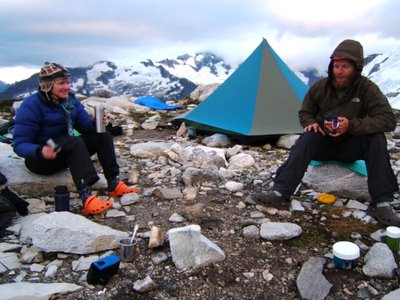
 Here are some pics (not in order yet---) from Erin Pettit and crew's (Rob, Seth, Matt and me) survey of N. Klawatti Glacier in the N Cascades--- we gained over a mile in elevation (going down and scrambling was the hardest for my Ohio legs--- The views were stunning and Erin's work will likely further illustrate the extent of glacier retreat in this region.
Here are some pics (not in order yet---) from Erin Pettit and crew's (Rob, Seth, Matt and me) survey of N. Klawatti Glacier in the N Cascades--- we gained over a mile in elevation (going down and scrambling was the hardest for my Ohio legs--- The views were stunning and Erin's work will likely further illustrate the extent of glacier retreat in this region. It started me how little snow there was in the accumulation zone of the N. Klawatti considering the heavy sn0wfall this winter. It was on average just a few meters deep... except in one depth probe, I found the snow to be 5, 6, no infinite meters... oh, wait that was a crevasse...
It started me how little snow there was in the accumulation zone of the N. Klawatti considering the heavy sn0wfall this winter. It was on average just a few meters deep... except in one depth probe, I found the snow to be 5, 6, no infinite meters... oh, wait that was a crevasse... 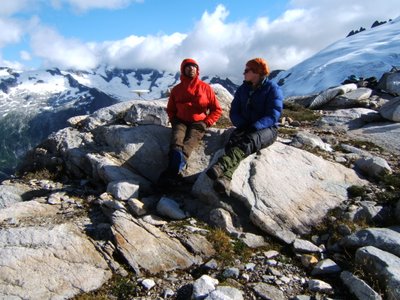
Glaciers are beautiful ---their treachery augments their allure.... After a long first day of hiking up, we spent the next day confined to our tents as sleet, snow and rain socked us in (a whiteout hovered above us blending glacier snow and ice with sky in one continous plane) --- on the third day navigated four glaciers, including lowering our packs over an arete and belaying ourselves from rock to ice. (One glacier was aptly named Inspiration, likely from the size of its gaping crevasses that inspired us to focus on steady footing). The fourth day we surveyed full force- two heading down to the N Klawatti ablation zone (where the glacier ice is exposed and the snow has melted) and me, Erin and Seth heading up into the accumulation zone. We completed around 10 total transects across the glacier.
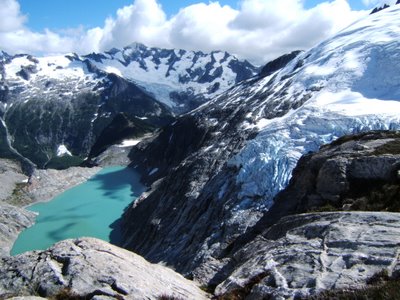
On the final day we hiked 13 hours out (I was slow going out on the final descent, practicing on the bike path isn't quite the same...) I learned some new advice including trying to land gingerly on my feet rather than plodding on the descent... much like the rest step helps with going uphill this saves the knees on the descents. Also, I'm heading out to get some Crocs before Girls on Ice... lightweight plastic clogs with air holes that leave heals free to dry out after a long hike... these clogs weigh about the same as a pair of flip flops...
Can't wait to help Erin and CeCe teach the girls about glaciers!!!
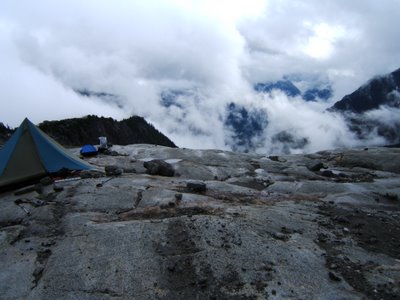 One more tidbit---on the way down the trail we ran into a crew of Texan tourists who were very interested in global warming. The retreat of the glaciers in the N Cascades has accelerated in recent decades. 10 meters on average per year... (of terminus retreat)... that is over 30 feet.
One more tidbit---on the way down the trail we ran into a crew of Texan tourists who were very interested in global warming. The retreat of the glaciers in the N Cascades has accelerated in recent decades. 10 meters on average per year... (of terminus retreat)... that is over 30 feet.We recommended seeing Al Gore's movie An Inconvenient Truth (or the book for that matter). Our actions on this planet have consequences- the fuels we burn, the land we till, the fertilizer we use.
Wednesday, July 26, 2006
Cascading Glaciers
Tomorow I leave Columbus for Seattle- and its off to the ice! Erin Pettit a glaciologist from University of Washington Seattle has been busy with field GPS surveys all summer. On Saturday, Erin, me and a few others will head up the North Klawatti Glacier in Marblemount, Washington to help Erin complete her surveys. We may summit El Dorado peak before we return on Tuesday.
Next on the list is Girls on Ice, the program Erin has run out of the North Cascades Institute (picture below from Megan McGintey http://www.ncascades.org/programs/youth/girls_on_ice/)
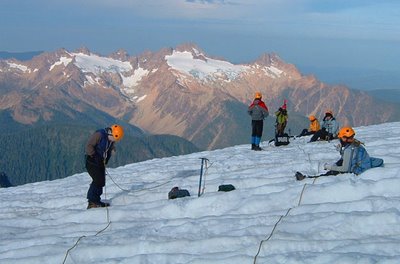
This ten day field glaciology program will be exciting!!! The girls attending this season sound excellent, representing top notch 15-19 year olds from around the world. I will update with pictures from both trips as soon as possible. Leading Girls on Ice is Erin (she's a physics- based glaciologist whose research includes studying cliff face dynamics in the McMurdo Dry Valleys) and I will assist Erin and teach the girls field glaciochemistry. My advisor, Berry Lyons, loaned some test kits that we can use to perform simple analyses on glacial streams. The principal mountaineer will be none other than Cecelia Mortenson! It is a small world indeed to see CeCe after our adventures hauling a golf bag up the Asgard Range, Antarctica. This time, I shall have ample candy bars - ready for the unexpected- when granola bars just doesn't cut it.
Next on the list is Girls on Ice, the program Erin has run out of the North Cascades Institute (picture below from Megan McGintey http://www.ncascades.org/programs/youth/girls_on_ice/)

This ten day field glaciology program will be exciting!!! The girls attending this season sound excellent, representing top notch 15-19 year olds from around the world. I will update with pictures from both trips as soon as possible. Leading Girls on Ice is Erin (she's a physics- based glaciologist whose research includes studying cliff face dynamics in the McMurdo Dry Valleys) and I will assist Erin and teach the girls field glaciochemistry. My advisor, Berry Lyons, loaned some test kits that we can use to perform simple analyses on glacial streams. The principal mountaineer will be none other than Cecelia Mortenson! It is a small world indeed to see CeCe after our adventures hauling a golf bag up the Asgard Range, Antarctica. This time, I shall have ample candy bars - ready for the unexpected- when granola bars just doesn't cut it.
Sunday, July 09, 2006
Design Intelligent Science Standards
Headlining the Columbus Dispatch Metro Section (7/9/06):
Revisiting intelligent design
--- The synapsis- Several Ohio education board members suggest that science standards on topics such as evolution, global warming, stem-cell research, and cloning need to provide a template "so schools would be comfortable discussing controversial issues."
Controversial issues. Not to scientists... why are non-scientists allowed to look at science without recognition of the long, hard, years and years of research that went into developing these theories?
Are these issues controversial because people aren't educated in the true nature of what is a scientific theory? A theory is not just a speculation... a theory is something that can be proven again and again and again.... new fossil finds support evolution...new climate records examined continue to show that fossil fuel burning is leading to overall global warming... My 'theory' that is going to rain tomorrow is not a theory.... but a guess...a hypothesis.... a belief... (nothing against beliefs...I have them too, but as a scientist, I try to not intermix my personal beliefs in scientific discussions-- keeping the science science)Let's teach students they can still have their guesses and beliefs... but scientific theories hold as long as they withstand future testing.
Is it any wonder that Ohio State education standards are trailing behind reading and math, when one of the proposed questions on state science exams is: "Describe that scientists may disagree about explanations of phenomena, about interpretations of data or about the value of rival theories, but they do agree that questioning response to critism an open communications are integral to the process of science...Discuss and be able to apply this in the following areas: global warming; evolution theory; emerging technologies and how they may impact society, e.g cloning or stem-cell research"
This question has no place in a state science exam....
This is philosophical... this is belief. Keep this discussion outside of science classrooms.
Revisiting intelligent design
--- The synapsis- Several Ohio education board members suggest that science standards on topics such as evolution, global warming, stem-cell research, and cloning need to provide a template "so schools would be comfortable discussing controversial issues."
Controversial issues. Not to scientists... why are non-scientists allowed to look at science without recognition of the long, hard, years and years of research that went into developing these theories?
Are these issues controversial because people aren't educated in the true nature of what is a scientific theory? A theory is not just a speculation... a theory is something that can be proven again and again and again.... new fossil finds support evolution...new climate records examined continue to show that fossil fuel burning is leading to overall global warming... My 'theory' that is going to rain tomorrow is not a theory.... but a guess...a hypothesis.... a belief... (nothing against beliefs...I have them too, but as a scientist, I try to not intermix my personal beliefs in scientific discussions-- keeping the science science)Let's teach students they can still have their guesses and beliefs... but scientific theories hold as long as they withstand future testing.
Is it any wonder that Ohio State education standards are trailing behind reading and math, when one of the proposed questions on state science exams is: "Describe that scientists may disagree about explanations of phenomena, about interpretations of data or about the value of rival theories, but they do agree that questioning response to critism an open communications are integral to the process of science...Discuss and be able to apply this in the following areas: global warming; evolution theory; emerging technologies and how they may impact society, e.g cloning or stem-cell research"
This question has no place in a state science exam....
This is philosophical... this is belief. Keep this discussion outside of science classrooms.
Thursday, June 29, 2006
Looking for cold life
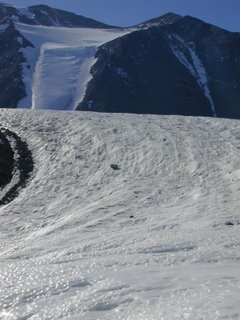 Life in Ice
Life in IceThe hot churning earth, volatile gases, fiery sparks, meteorites, primordial water... or something much, much colder. In 2002, Dr. John Priscu from Montana State University spoke briefly at Byrd Polar Research Center (OSU) on the strange organisms inhibiting the lakes at the base of polar mountain glaciers in the McMurdo Dry Valleys (MCM). In his conclusions, Dr. Priscu suggested that life was more enduring in the cold and more preserved. Genetic material and whole organisms have been preserved and even revived after thousands of years trapped in ice (Christner et al., 2001). At the conclusion of his talk, Dr. Priscu asked, “Are icy conditions ideal for the beginnings of life, on earth or other planets?”
Are polar mountain glaciers are the most accessible places to investigate this question? On mountain glaciers at all latitud
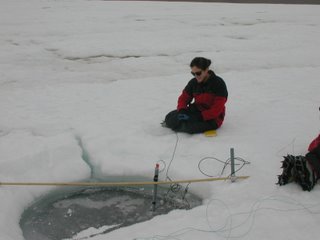 es micro and macro-organisms have made homes in small, enclosed melt pocks on the glacier surface, better known as cryoconite holes. Cryoconite holes form as dark sediment blown or falling on the glacier surface is heated by the sun, melting into the glacier surface. In temperate glaciers... warmer temperatures and longer melt seasons often cause these holes to have a rapid lifespan, forming and then flushing from the glacier--- connecting in a network of supraglacial streams (streams flowing on the glacier surface) and or exiting through fractures inside the glacier. Polar glaciers are unique, the Arctic and Antarctic host cryoconite holes thatare isolated for as many as 10 years (maybe much more); sealed from atmospheric exposure by ice lids that are several centimeters thick. When these flush (pictured), the organisms entombed may end up back in proglacial lakes. Their unique chemistries may provide some hints on the type of life we might expect to find in icy planets...
es micro and macro-organisms have made homes in small, enclosed melt pocks on the glacier surface, better known as cryoconite holes. Cryoconite holes form as dark sediment blown or falling on the glacier surface is heated by the sun, melting into the glacier surface. In temperate glaciers... warmer temperatures and longer melt seasons often cause these holes to have a rapid lifespan, forming and then flushing from the glacier--- connecting in a network of supraglacial streams (streams flowing on the glacier surface) and or exiting through fractures inside the glacier. Polar glaciers are unique, the Arctic and Antarctic host cryoconite holes thatare isolated for as many as 10 years (maybe much more); sealed from atmospheric exposure by ice lids that are several centimeters thick. When these flush (pictured), the organisms entombed may end up back in proglacial lakes. Their unique chemistries may provide some hints on the type of life we might expect to find in icy planets...Dusty glaciers
Dustand water are the two criteria found in most hot and cold origins of life scenarios (Here and on other planets). Yet, cold temperatures best preserve genetic material including RNA and DNA, which
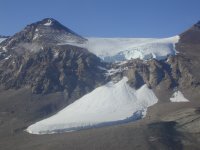 are destroyed at temperatures above 100ºC (Rothschild and Mancinelli, 2001). There is no genetic evidence that the first organisms preferred hot conditions as many original early life hypotheses proposed (Galtier et al., 1999). Cold-water brines contain much more HCN (hydrogen, carbon, nitrogen--- aka the building blocks of life) and preserve seven times more life essential amino acids than their warm water counterparts (Rothschild and Mancinelli, 2001). Organisms have been revived after freezing to temperatures of –196ºC (Rothschild and Mancinelli, 2001).
are destroyed at temperatures above 100ºC (Rothschild and Mancinelli, 2001). There is no genetic evidence that the first organisms preferred hot conditions as many original early life hypotheses proposed (Galtier et al., 1999). Cold-water brines contain much more HCN (hydrogen, carbon, nitrogen--- aka the building blocks of life) and preserve seven times more life essential amino acids than their warm water counterparts (Rothschild and Mancinelli, 2001). Organisms have been revived after freezing to temperatures of –196ºC (Rothschild and Mancinelli, 2001).Glacier ice on earth, especially polar glacier ice with higher stratospheric deposition, contains high concentrations of inorganic nitrogen (Hodson et al., 2005). Temperate and poly-thermal glaciers elute (or leach out) soluble ions including nitrate during the early part of the melt season.
Micro-elution of glacier salt occurs within the ice lattice itself. In 1981 Maccagnan suggested that acids occupied liquid sheets along ice crystal grain boundaries. Acids commonly found in glacier ice, including nitric, have much lower freezing temperatures than water perhaps aiding their migration (Fukazawa et al., 1998; Maccagnan, 1981; Price 2000). Laboratory Scanning Electron Microscope (SEM) studies on glacier ice reveal soluble salts are located along some grain boundaries. Soluble salt fluctuations in the Greenland (GRIP) ice core showed percolation during the Eemian warm period (125,000-115,000) (Rempel et al., 2001).
Bacteria revitalized from ice cores at all latitudes have likely endured repeat cycles of melt and refreeze along with extreme UV exposure and variation (Christner et al., 2000). Isolates revived from glacial ice are from spore groups with high tolerance to environmental change (Christner et al., 2000). The greatest bacterial diversity appeared in tropical ice cores, closer to plant-rich ecosystems excepting the dusty Taylor Dome ice core (Christner et al., 2000). The importance of dust may be critical to identifying the most viable extraterrestrial glacier ecosystems. Dust is likely to be dissolving in glacier melt trapped in cryoconite holes and intergranular ice boundaries (Fukazawa et al., 1998; Tranter et al., 2004). Life is most observed on glaciers in association with high rock:water ratios.
Cold Life on Earth
The McMurdo Dry Valleys (MCM) at 76º30’ to 78º30’ S, 160º to 164 E host the most extreme polar glacier mountain environments on the planet. The MCM is a polar desert, representing the largest ice-free region in Antarctica (Drewry et al.,1982). Annual temperatures average –20 ºC as measured by valley floor meteorological stations (Fountain et al., 1998). Glaciers are the primary source of water to the ice-covered lakes.
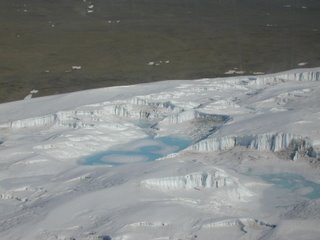 During the austral summer, proglacial streams flow for four to fourteen weeks a year. Yet, sublimation (evaporation), not melt, is the primary source of ablation to MCM glaciers (Fountain et al., 1998). Energetically, sublimation requires almost 8 times more energy than melt, therefore, MCM glacier ablation rates are much lower than temperate glaciers of similar sizes (Fountain et al., 1998). Taylor Valley, one of three MCM valleys, runs W to E from the Taylor Glacier, an outlet of the East Antarctic Ice Sheet, to the Ross Sea, and is bounded on its north by the Asgard Range and on its south by the Kukri Hills. Strong katabatic winds flow down the East Antarctic Ice Sheet into Taylor Valley carrying valley floors sediment east onto the lakes and glacier surfaces. Lesser winds also transport dust west from the Ross Sea as indicated by the unique glacier chemistries and grain-size distribution on the west and east side of glaciers (Fortner et al., 2005; Lyons et al., 2003).
During the austral summer, proglacial streams flow for four to fourteen weeks a year. Yet, sublimation (evaporation), not melt, is the primary source of ablation to MCM glaciers (Fountain et al., 1998). Energetically, sublimation requires almost 8 times more energy than melt, therefore, MCM glacier ablation rates are much lower than temperate glaciers of similar sizes (Fountain et al., 1998). Taylor Valley, one of three MCM valleys, runs W to E from the Taylor Glacier, an outlet of the East Antarctic Ice Sheet, to the Ross Sea, and is bounded on its north by the Asgard Range and on its south by the Kukri Hills. Strong katabatic winds flow down the East Antarctic Ice Sheet into Taylor Valley carrying valley floors sediment east onto the lakes and glacier surfaces. Lesser winds also transport dust west from the Ross Sea as indicated by the unique glacier chemistries and grain-size distribution on the west and east side of glaciers (Fortner et al., 2005; Lyons et al., 2003).Melt and sublimation features including internal cliffs, ponds, channels and cryoconite holes exist on many of the MCM glaciers, most developed at dusty and low elevation sites (observation). Dusts (salts) from the valley floor, melt into the glacier surface forming cryoconite holes, or ice-lid covered melt pools, ranging from 5 cm to 145 cm in diameter (Tranter et al., 2004; Fountain et al., 2005) .
Cryoconite holes are the most easily identified habitats existing on MCM glaciers (Tranter et al., 2004; Wharton et al., 1981). Biotic colonies are well-documented within MCM mountain glacier cryoconite holes including cyanobacteria, rotifers, tardigrades and ciliates (Porazinska et al., 2004; Tranter et al., 2004). In cryoconite holes nitrogen is fixed from ice by photoautotrophs, or inorganic nutrient fixers whose primary energy is from the sun (Tranter et al., 2004). Nitrification by microbes is likely to occur in oxic cryoconite holes, whereas other microbes in the suboxic glacier bed exist via denitrification and sulfate reduction (Hodson et al., 2005; Tranter et al., 2004). Anoxic conditions may even be met significant basal organic matter promoting methanogenesis and thus varying sub-oxic- anoxic communities along the glacial bed (Skidmore et al., 2000; Tranter et al., 2005). Non-basal ice also contained microbial life, significantly less abundant than dirty basal ice (Skidmore et al., 2000).
Cryoconite holes in the MCM contain significant dust and host much more observable life than supraglacial streams (Tranter et al., 2004). Snow cover buffers Antarctic soil organisms from harmful UV (Cockell and Cordoba-Jabonero, 2004). However, ice lids and dust may be buffering cryoconite hole organisms from UV exposure and premature death. Glacier snow and dust may offer organisms shielding on other higher UV planets. At all Eh conditions, high concentrations of soluble acids (from atmospheric and weathering inputs) are microbial food (Hodson et al., 2005; Tranter et al., 2005). Therefore, atmospheric redox conditions on Mars and other planets may be of less importance to life than the presence of dust and water.
Biotic compositions in MCM cryoconite holes are not representative of the communities existing in the immediately neighboring soil, but may have complex mixing patterns related to larger-scale wind patterns (Poranzinka et al., 2004). Phylogenetic analyses of cryoconite hole species reveal similarities between lake and streams, indicating that through wind transport of biology containing soil aggregates material is transported between the valley floor and glacier (Christner et al., 2003). Cryconite holes development is attributed largely to solar melting, the holes higher on MCM glacier were of similar diameters to lower cryoconite holes and all holes contained similar amounts of sediment (Porizanska et al., 2004). This is contrary to expectations with lower wind-blown sedimentation observed at higher glacier elevations (Lyons et al., 2003). Similarly, cryoconite holes on the western sides of glaciers were of the same size as those on the eastern sides (Poranzinka et al., 2004). Therefore, the size of holes may have some relation to the amount of heat generated by organisms, and thus the length of time these organisms are seasonally active (not in a frozen state) (Porazinka et al., 2004). Experiments killing all organisms in MCM cryoconite holes resulted in a decrease in cryoconite hole depth of 10% (Fountain et al., 2004).
High dissolved organic carbon (DOC), pH levels and observed organisms within MCM cryoconite holes were attributed to increased photosynthesis and enhanced DIC preservation (Tranter et al., 2004). Cryoconite hole solute chemistries were similar to African soda lakes, extremely elevated in comparison to melted glacier ice concentrations (Tranter et al., 2004). In a bi-polar comparison, Arctic cryoconite holes had much lower pH levels than Antarctic (Mueller et al., 2001). Lower arctic pHs were attributed to increased atmospheric acid inputs to Northern Hemisphere ice (Mueller et al., 2001). However, the MCM cryconite paper showed the least productive cryoconite holes had lower pHs and pCO2s indicating that they had been exposed to the atmosphere , therefore increased photosynthesis may lower acidities of sealed cryoconite holes (Tranter 2004). Lower nutrient and solute levels in Arctic cryoconite holes suggest that the system had recently flushed (Mueller et al., 2001). Arctic cryoconite holes had less biodiversity than MCM cryoconite holes although there was much higher organic content in the Arctic holes (Mueller et al., 2001). It may be that MCM cryoconite holes flush less frequently and are more stable environments for hosting life (Mueller et al., 2004).
Life on Martian Glaciers?
Mars cycles water atmospherically and has the potential to contain significant groundwater (Baker et al., 2005; Bibring et al., 2004). Martian water is best (or most easily) observed trapped in polar mountain glaciers, potentially making Martian glaciers the best place to look for life (Bibring et al., 2004; Skidmore et al., 2005). Although glaciers on Mars are primarily CO2 (dry-ice), recent infrared data shows that water is present, and distinguishable from CO2 ice (Bibring et al., 2004). Mars hosts a water-thin atmosphere (1,000 times less than earth), that is always near saturation (Baker et al., 2005), with near surface temperature means of –50ºC at the equator to –100ºC at the poles (NASA website). Martian glaciers may provide natural temperature stability, as surface ice temperatures will not vary as much as air. Glaciers may also act as natural sediment catchments in the frequent and forceful dust storms that engulf the planet. Dust storms may carry life bearing dust to polar glaciers to be activated with water. This contact may be especially possible in sublimation features found on Martian Glaciers that resemble those seen in the McMurdo Dry Valleys (including cryoconite holes!!!)
Conclusions and Future Directions
Dusty mountain glaciers may be the best place to examine to develope methods for looking for life on Mars and other planets, or to find the requirements for the beginnings of life in our own planet. More work needs to be done to assess the stability of MCM cryoconite holes and to determine if increasing atmospheric isolation--- thick ice lids---increase the productivity of cryoconite organisms. Additionally, geochemical work on stable isotopes of N, O, C, and Fe may reveal signatures of currently, or previously existing life in Martian glaciers. This work will best be understood by determining the biological fractionation that occurs of these elements within cryoconite holes and in subglacial settings (oxic-anoxic atmospheres). Organisms, sediments and solutes may all be analyzed to determine their interrelation and importance to interpreting the presence of life. MCM cryoconite holes are ideal for stable isotope investigations as they host high rock:water ratios conducive to life that may be analogous to glacier melt features on Mars and other icy planets.
References
Bada, J. L., 2004. Earth and Planetary Science Letters 226: 1-15.
Bada, J. L., and Lazcano, A., 2002. Science 296: 1982-1983.
Baker, V. R., Dohm, J. M., Fairen, A. G., Ferre, T. P. A., Ferris, J. C., Miyamoto, H., and Schulze-Makuch, D., 2005. Hydrogeology Journal 13: 51-68.
Bains, W. 2004. Astrobiology 4(2):137-167.
Capone, D. G., Popa, R., Flood, B., and Nealson, K. H. 2006. Science 312: 708-708.
Christner, B. C., Kvitko II, B. H., and Reeve, J. N., 2003. Extremophiles 7:177-183.
Christner, B., Mosley-Thompson, E., Thompson, L. G., Zagorodnov, V., Sandman, K., and
Reeve, J., 2000. Icarus 144: 479-485.
Cockell, C. S., and Cordoba-Jabonero, C. 2004. Photochemistry and Photobiology: 79(1): 26-31.
Cullen, D., and Baker, I., 2001. Microscopy Research and Technique 55: 198-207.
Drewry, D. J., Jordan, S.R., Jankowski, E., 1982. Annals of Glaciology 3: 83-91.
Fortner, S., Fountain, A., Tranter, M., and Lyons, W. 2005. Aquatic Geochemistry
Fountain, A. G., Tranter, M., Nylen, T., Lewis, K. J., and Mueller, D.R., 2004. Journal of Glaciology 50(168):35-45.
Fountain, A. G., Dana, G. L., Lewis, K., J., Vaughn, B. H., and McKnight, D., 1998. Ecosystems in a Polar Desert: The McMurdo Dry Valleys Antarctica. 65-75.
Fukazawa, H., K. Sugiyama, S. Mae, H. Narita, and T. Hondoh, 1998. Geophysical Res. Lett., 25: 2845–2848.
Galtier, N., Tourasse, N, and Gouy, M., 1999. Science 283:220-221.
Hodson, A. J., Mumford, P. N., Kohler, J., and Wynn, P. M., 2005. Biogeochemistry 72(2): 233-25.
Lyons, W. B., Welch, K. A., Fountain, A. G., Dana, G., Vaughn, B. H. 2003. Hydrologic Processes 17:115-130.
Mellon, M. T., and Jakosky, B. M., 1995. Journal of Geophysical Research 100: 11781-11799.
Mueller, D. R., Vincent, W. F., Pollard, W. H., Fritsen, C. H., 2001. Nova Hedwidgia 123: 173-197.
Porazinska, D. L., Fountain, A. G., Nylen, T. H., Virginia, R. A., and Wall, D. H., 2004. Arctic, Antarctic and Alpine Research 36(1): 84-91.
Rempel, A. W., Waddington, E.D., Wettlaufer. J. S., Worster, M. G., 2001. Nature 411: 568-571.
Rothschild, L., J., and Mancinelli, R. L., 2001. Nature 409:1092-1101.
Skidmore, M., Foght, J. M., and Sharp, M. J., 2000. Applied and Environmental Microbiology
Tranter, M., Skidmore, M., and Wadham, J. 2005. Hydrological Processes 19: 995-998.
Wharton, R. A., Jr., Vinyard, W. C., Parker, B. C., Simmons, G. M., Jr., Seaburg, K. C., 1981. Phycologia 20(2): 208-211. 66(8): 3214-3220.
Monday, June 26, 2006
Carbon: What is photosynthesis anyway?
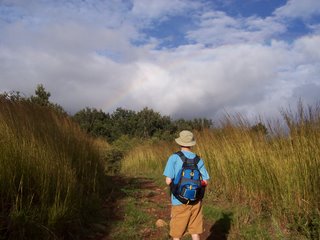 Although most high school graduates successfully answer test questions on photosynthesis- most people don't really understand where the mass of trees/plants comes from.... a group of high school students as well as a group of recent Harvard graduates were asked at their respective commencement ceremonies- where does the mass of a tree come from?
Although most high school graduates successfully answer test questions on photosynthesis- most people don't really understand where the mass of trees/plants comes from.... a group of high school students as well as a group of recent Harvard graduates were asked at their respective commencement ceremonies- where does the mass of a tree come from?Most people answered- 'from nutrients in the soil' 'from the sun' 'from photosynthesis'...when they had to explain photosynthesis- the end product, the bulk of plant mass was never identified.
Not one person interviewed understood that the carbon dioxide (gas) in our atmosphere was converted into solid carbon. Yes gas has mass. Earth's plants are carbon.
It made me very frustrated, but shed some light on why so many people don't understand global warming. The most tangible aspect of the carbon cycle (trees, plants etc.) is only a quickly learned recitation... and yet most of us burn carbon daily... and lots of it....
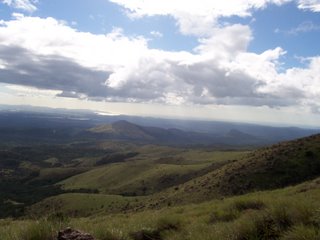 Plants (Carbon) die and are buried for millions of years and metamorphose into fossil fuel---Those fuels remained buried in the earth... sequestered..Now we burn them in our industries, I burn carbon driving my Prism, watching t.v., writing this blog.
Plants (Carbon) die and are buried for millions of years and metamorphose into fossil fuel---Those fuels remained buried in the earth... sequestered..Now we burn them in our industries, I burn carbon driving my Prism, watching t.v., writing this blog.Carbon that was once stored is now burned and released in our atmosphere (as carbon dioxide) the actual quantity of carbon dioxide in our thin atmosphere is increasing... (we can tell that conclusively by looking at atmospheric bubbles that are trapped in ice cores that go back 650,000 years (EPICA). In the last 650,000 years we have never had an atmosphere with as much carbon dioxide in it as we do now. Not during any other warm period (interglacial).
The concentration of carbon dioxide in the atmosphere relates to the temperature on earth... we need some carbon dioxide in the atmosphere to keep us warm and to feed the hungry plants and trees... but the extra carbon dioxide trapped in our atmosphere is heating us up.
Things are getting warmer now...not all days, not all places, but globally. Greenland's majestic glaciers. Huge walls of daunting ice thinning into puddles. If the whole thing goes, which is predicted for my lifetime that means 7 meters of sea level rise.... 15-20 feet...(Washington D.C. and much of Florida will be underwater) this will displace many populations especially in Asia
...many of the mountain glaciers I visited early in my lifetime will be gone by the end of it. Gone is the awing Illecillewaet that I viewed from a quiet perch at 19.
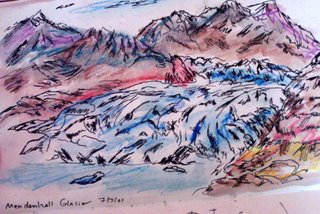 The Eliot Glacier, a popular ski spot, a name on the map, the majestic Mendenhall a bowl in the valley. It is very sad to me at a gut level--- a loss of what is beautiful. But there are more serious consequences ... even dire... think of the people in the Himalayas reliant on glacial melt for water...extreme thirst, parched throats.
The Eliot Glacier, a popular ski spot, a name on the map, the majestic Mendenhall a bowl in the valley. It is very sad to me at a gut level--- a loss of what is beautiful. But there are more serious consequences ... even dire... think of the people in the Himalayas reliant on glacial melt for water...extreme thirst, parched throats.Or worse yet,- will West Antarctica (or more) melt?
Keep burning fossil fuels. Make some money now-
Don't think too hard about your beach house on the coast, you're rich you can always rebuild when the coast moves inland 100-1000 feet. And yet, business as usual is considered the easiest choice. Since the industrial revolution we have burned fossil fuel... raking in the dough. Economics will still exist if we move to other fuels....California has a huge economy and is by far more green than any other state.
And, yes I drive... feeling a bit ill thinking about it....but I can't say that I want the solution to take away the liberty we have in our economy...
I am writing letters in favor of a light rail system, buying local produce (less transport required for food--- no more kiwi fruit, and vow to only invest in companies with sustainable practices... and those at the forefront of energy efficient technology- nanotechnology looks especially profitable-)
We have added insulation to our house, installed low energy flourescent light bulbs, and have committed to making our future home 100% off the grid (we will have solar, and geothermal energy).
As a person who is educated in the consequences of increasing atmospheric carbon dioxide it is my duty to make decisions that reflect this. It is my hope that the public will join the scientific community to demand more efficient energy use and the weaning from fossil fuels.
Floods are instantaneous, but we do not instinctively connect them to climate change. The gradual raise of sea level, the change of climate (shifting agriculture, land practice) these happen too slowly for us to register, to connect with our current energy practices. I hope people are starting to feel the water on their toes like me. Because the water will be over our children's heads. If we had to drop them into the bottom of the pool now- would that make our energy choices easier?
Tuesday, March 14, 2006
Snow Snow Snow
 Hello all! Yesterday, I returned safely from this weekend's adventures on Mount Hood. Snowpit sampling and logistics were handled by a great team- Hiram Henry, Janelle Mueller, Jan Dougall, and Dave Dranchak (folks from Portland State University and/or former Juneau Icefield Participants). The goal- to resample just below my summer sampling location on Snowdome and compare the fresh snow trace metal signature to the melting summer snow (collected last June). We had plenty of snow- so much that I nearly cancelled the trip the day before... avalanches are a big concern in the Cascades this year with record snowfall---- the reports were ominous with avalanche warnings at moderate levels, it could get worse if the storms continued. Jan called the day before reporting snow in Portland (which rarely happens...) However, as the day continued the outlook improved and it looked like the Cooper Spur road to the trailhead would be plowed and avalanche hazards minimal- due to the relatively consistent nature of the snow...
Hello all! Yesterday, I returned safely from this weekend's adventures on Mount Hood. Snowpit sampling and logistics were handled by a great team- Hiram Henry, Janelle Mueller, Jan Dougall, and Dave Dranchak (folks from Portland State University and/or former Juneau Icefield Participants). The goal- to resample just below my summer sampling location on Snowdome and compare the fresh snow trace metal signature to the melting summer snow (collected last June). We had plenty of snow- so much that I nearly cancelled the trip the day before... avalanches are a big concern in the Cascades this year with record snowfall---- the reports were ominous with avalanche warnings at moderate levels, it could get worse if the storms continued. Jan called the day before reporting snow in Portland (which rarely happens...) However, as the day continued the outlook improved and it looked like the Cooper Spur road to the trailhead would be plowed and avalanche hazards minimal- due to the relatively consistent nature of the snow... After waking up at 5 am in Columbus, I arrived in Portland at 11 a.m. We were skiing up Mount Hood toward the Tilly Jane Cabin by 5 p.m. Shovels, avalanche probes, beacons, and sampling equipment in tow. (Safety = Good Science) The uphill ski took us just under 5 hours. Fortunately, we did not have to break trail- earlier skiiers had paved the way to the cabin... and we were blessed to ski in the moonlight the whole evening. Hiram had his compass out just in case... The moon nearly full provided ample light and it was refreshing after 6 hours on the plane and a few hours of studying in the airport... we were in great spirits!
After waking up at 5 am in Columbus, I arrived in Portland at 11 a.m. We were skiing up Mount Hood toward the Tilly Jane Cabin by 5 p.m. Shovels, avalanche probes, beacons, and sampling equipment in tow. (Safety = Good Science) The uphill ski took us just under 5 hours. Fortunately, we did not have to break trail- earlier skiiers had paved the way to the cabin... and we were blessed to ski in the moonlight the whole evening. Hiram had his compass out just in case... The moon nearly full provided ample light and it was refreshing after 6 hours on the plane and a few hours of studying in the airport... we were in great spirits!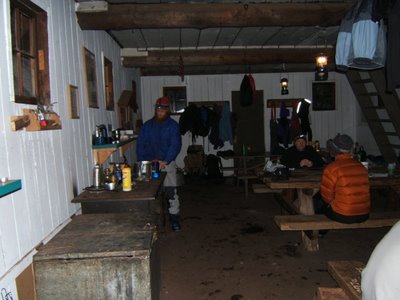
Arriving at the Tilly Jane Cabin felt great! I had been awake for nearly 20 hours, and skiing uphill with sampling and sleeping equipment isn't as easy as Hiram (an Alaskan native) makes it look. A group of backcountry skiiers and snowboaders had the wood burning stove blazing and we quickly settled into the rustic comfort. Dinners ranged from sandwiches to gourmet pasta dishes, depending on what people had packed in- but the generous snowboarders offered us all hot water for drinks and to fill our nalgenes for the next day's ski. After eating well, playing a round of cards, and laying out my thermarest in the loft above the kitchen area, I fell soundly to sleep nevermind the jungle of snoring snowboarders. A thermarest can feel like down if you are tired enough.
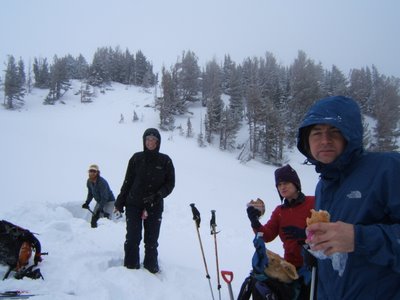 We woke up slowly, to enjoy the morning, Dave even had a little metal espresso maker- but after eating, double-checking our equipment, and strapping on avalanche beacons (they are transmitters to aide rescue), we skiied uphill once more... heading above treeline to fresh undisturbed snow.
We woke up slowly, to enjoy the morning, Dave even had a little metal espresso maker- but after eating, double-checking our equipment, and strapping on avalanche beacons (they are transmitters to aide rescue), we skiied uphill once more... heading above treeline to fresh undisturbed snow. This didn't take long, we found a good fresh patch within two hours. By the time Dave, Jan, and Janelle and I had eaten our sandwiches, Hiram had dug a pit. (We all offered to help after eating, but Hiram was particularly enthusiastic). Before Jan and I put the clean suits on to avoid contaminating the pit with dust from our clothes- Hiram demonstrated how to check the safety of the snow by looking for inconsistent densities... I learned something new- I had no idea that depth hoare could form on temperate glaciers... depth hoare is snow that is less dense that its surrounding layers- (it forms on polar glaciers in areas of high sublimation)... Anyway, given the right radiation and wind conditions depth hoare may also form in temperate glaciers...
Both depth hoare and ice lenses (melted and refrozen snow) create instability in the snow, making easier planes for the snow to slip on--- luckily, our poking into the side of the snowpit revealed the snow was a relatively consitent density for at least the top meter. (This is something I had just been studying at home in Paterson for those glacier physics freaks).
Once we established the snow was safe, Hiram, Janelle and Dave went skiing nearby and Jan and I began sampling. The sampling went quickly with great snow conditions! Jan and I managed to finish sampling and pack up a half hour before the skiiers returned. By 4 p.m. we were skiing down the mountain, enjoying great snow conditions and samples! We stopped at the Tilly Jane to pack up the avalanche equipment and repack our sleeping gear. Then we headed down the mountain. Skiing felt wonderful, it was a bit tougher for me, having not telemarked in awhile, but I put skins on and had no difficulty skiing down with the extra friction--- Hiram skiied the best, even after his binding broke, at which point he strapped his useless ski on his pack and continued skiing on one foot easily through the woods...
Unfortunately, we overshot our cars and ended up just below the Cooper Spur Ski Resort. The sky darkened and in moonlight once more, we followed the road up 2 km to the vehicles. Seeing the cars brought smiles!
Thank goodness for Thai food. By the time we made it to Portland (10 pm) all of us were grateful that we could enjoy a warm meal together. I couldn't have asked for a better team. Not everybody would maintain such high spirits given the detours we had that day- but our team was excellent. Everyone focused on collecting samples, and logistics were well planned by the PSU crew. I am very happy to have had this experience with Hiram, Janelle, Jan, and Dave.
Sunday, January 22, 2006
The Fonz
 Hi everyone, I made it safely back to Ohio- after a delay in Los Angeles... my flight to Chicago was cancelled due to snow. Thankfully, there is a distressed passenger rate at the Hilton- I had a nice afternoon reviving myself after the 12 hour flight from Auckland, New Zealand. My flight for Ohio via St. Louis left yesterday morning at 6:30, so I arrived at the airport to massive lines. People swarming like sluggish ants at 4:30 in the morning . Going through security- the Fonz and I had a good pre-caffeinated chat. He was heading to Dallas, Texas. Wearing a purple Mr. Rogers sweater with a fancy and flamboyant scarf.
Hi everyone, I made it safely back to Ohio- after a delay in Los Angeles... my flight to Chicago was cancelled due to snow. Thankfully, there is a distressed passenger rate at the Hilton- I had a nice afternoon reviving myself after the 12 hour flight from Auckland, New Zealand. My flight for Ohio via St. Louis left yesterday morning at 6:30, so I arrived at the airport to massive lines. People swarming like sluggish ants at 4:30 in the morning . Going through security- the Fonz and I had a good pre-caffeinated chat. He was heading to Dallas, Texas. Wearing a purple Mr. Rogers sweater with a fancy and flamboyant scarf.The Fonz is a much smaller (width and height) and softer spoken man than I expected. After our 15 minute line wait, he grabbed my running shoes off the security for me through security and wished me a good flight. That's about as much as I remember at 5 in the morning after 24 hours of flying....
Heyyyyyyyyyy!
Subscribe to:
Comments (Atom)

